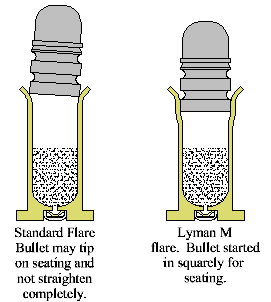Stagpanther,
It appears some confusion has occurred. There are two kinds of expander. You have one in your sizing die, but not the other.
The problem the die maker has with any standard resizing die or even with roll sizing equipment is that brass has a wall thickness tolerance, so when the mouth of the case is withdrawn from the die, the inside diameter will vary by that tolerance. The one-size-fits-all-brass solution is to make the neck diameter inside the die small enough to adequately resize the thinnest brass in the tolerance range far enough to still succeed in gripping a bullet. Then, because most brass will not be that thin and will therefore be over-resized, use an expander to set the undersized neck ID for a bullet start in.
There are two approaches to this. The kind of expander you have is generally in all sizing dies made for bottleneck cases. It expands the mouth of the bottleneck case as you withdraw it from the die to give minimum necessary bullet hold. In a bottleneck case, this solves two problems. One is to make the grip on the bullet uniform, which matters to accuracy. (Normally, this is a rifle accuracy level consideration.) Second, by not asking the bullet to expand the case mouth too much, the risk of collapsing the case at the shoulder with excessive seating force is minimized. If it weren't for this latter consideration, you could bell the mouth of an over-resized rifle case and let the bullet do all it own expanding, though this tends to allow the bullet to tilt more during seating, affecting accuracy. The amount of effect is on the order of 1 moa worst case added scatter, so you don't usually notice it at typical handgun ranges.
To prevent scraping copper off bullets and further reduce the chance of collapsing a shoulder, normal practice is to chamfer cases expanded that way with
a chamfering tool. If you've had to trim cases, you also chamfer again plus deburr the outside of the mouths with the other end of that tool. This needs to be done the first time you form and load the case and again after any subsequent trimming you might find necessary.
Commercial ammunition makers typically do not chamfer cases, simply tumbling the sharp edges off after cutting the neck to final length. However, many times I've seen small rings of copper scraped off the sides of bullets being seated in the unchamfered brass. This is another thing whose affects are most notable in rifle cartridges, affecting both accuracy and, in some chambers, metal fouling.
That first kind of expander cannot be used sizing in sizing dies for straight wall cases. A carbide sizing ring would just squeeze the expansion back out again, and a full length steel die wouldn't let it fit together with a case. So, belling the case mouth to prevent the bullet catching on it and in lieu of chamfering, and then letting the bullet do its own expanding of the case neck works well enough with handgun cartridges. The shoulderless sides of a straight or nearly straight case creates support column geometry that is much more resistant to collapse than a bottleneck case is. The only problem with belled case mouths is bullet tilt with seating this way is commonly large if the seating die isn't custom made for the bullet nose.
To check for tilt, look where the bullet base heel is mirrored in the case surface as a slight bump up in diameter of the case wall. It is often more pronounced on one side of the case than the other. This is due to bullet tilt. It doesn't seem to affect jacketed pistol bullets much that I can tell, but can make cast bullets significantly less accurate. It may be virtually eliminated as described below.
It is this second kind of expander function that the operating/drop tube of the Dillon powder measure performs. If you have that, you skip chamfering. However, getting the second kind of expander function is easy using either the inexpensive
Lee Universal Neck Expanding Die, or, my personal preference, a
Lyman Multi-Expander Die.
The latter die costs twice as much, but it comes with inserts for all common handgun calibers, and not just 9 mm. It puts a small step in the case (see below) that the bullet sets into, forcing it to start straight into the case. This virtually eliminates bullet tilt. It is also a powder-through die, which is convenient if you throw charges either from an electronic weighing dispenser or from scoops (you still need a funnel) and it has female threads at the top that accommodate standard threaded powder measures. The belling is also called flaring. Whatever mouth expansion of this kind you do is ironed out by setting your seating die's crimp shoulder down just far enough to remove it, or by using a separate crimp die.











